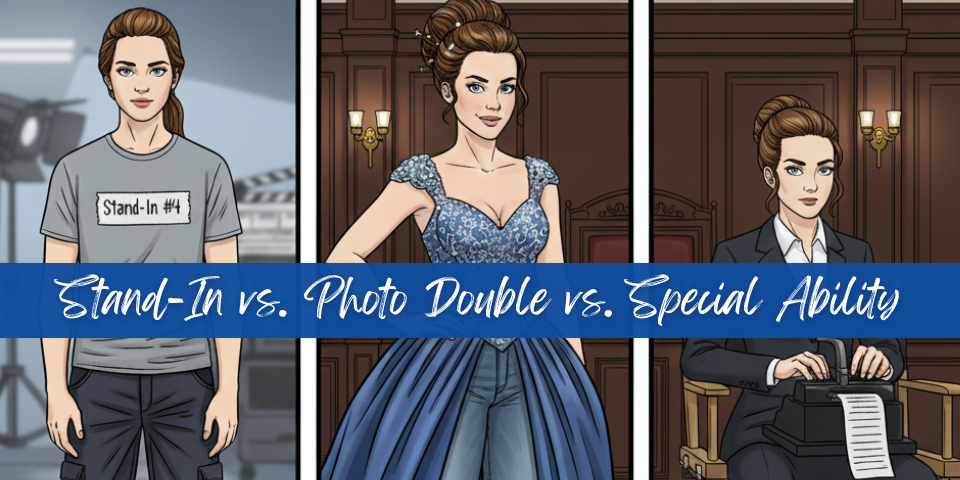If you’ve never worked as a stand-in on a TV show or film, you may not be aware of the wide range there is of stand-in jobs. But if you’ve worked regularly as a TV/film stand-in on a number of different productions, you may be fully aware of just how much range there is.
With that range comes a range of difficulty. Some stand-in jobs can be so simple that basically anyone can do them. Other stand-in jobs are so challenging that they are suited for skilled professionals with acting and on-camera experience.
In this post, Stand-In Central attempts to grade in terms of difficulty the kinds of stand-in jobs you may encounter in TV and film.
Of course, stand-in jobs are not so rigidly categorized, these ratings are subjective, and one day as a stand-in on one production may be easy, while the next day on it could be very difficult.
Are you working as a stand-in? Then how difficult do we grade your job? Read on to find out!
Grade 0
Grade 0 stand-in jobs are the easiest. Grade 0 jobs are basically just those jobs when you are hired as a stand-in, but then you never work.
It is almost silly to consider these kinds of stand-in jobs, but in truth, they exist. Sometimes, you get hired as a stand-in and don’t work. That’s a Grade 0 difficulty stand-in job.
Grade 1
Grade 1 stand-in jobs are easy. If you can stand on a mark, sit on a chair, or line in a bed, then you are doing a Grade 1 stand-in job.
In general, for Grade 1 stand-in jobs, you need no particular experience on a TV or movie set. You are just invited to set, asked to stand, sit, or lie down somewhere, and you do that until you are excused. Nothing really more is expected of you.
In Grade 1 stand-in jobs, you might not even have seen a marking rehearsal. Meaning, on Grade 1 stand-in jobs, you probably have no more responsibility than being a subject to light and frame for cameras.
Grade 2
In Grade 2 stand-in jobs, you take on some basic level of responsibility. In Grade 2 stand-in jobs, you generally watch marking rehearsals, stand, sit, or lie down where your actor was, and you also do the basic movements your actor did in a scene. For example, if your actor did a cross to another actor in the scene, you do that same cross to another stand-in when asked to do so.
In Grade 2 stand-in jobs, you don’t tend to read any lines or have complex acting. You may have a basic sense of the rhythms of a set, but you might not know a lot of what directors, directors of photography (DPs), or camera operators really expect of you. All you really know to do is do your job, which from what you can tell is stand where your actor stands, sit where your actor sits, etc., and do any movements your actor does.
Grade 3
In Grade 3 stand-in jobs, you carry more responsibility than Grade 2 stand-in jobs. If you are standing in regularly on a production, and if you are able to keep the job, it may be because it is a Grade 3 job and you perform your job well.
When it comes to Grade 3 stand-in jobs, you may be more expert at executing your character’s movements. You watch the monitors during takes so if your actor makes a blocking change during a shot and if you go back to set, then you know to change your own blocking in accordance. You might read lines from time to time but not necessarily always. You might be asked to stand in for other actors, because you have a demonstrated skill to handle stand-in responsibilities and the production saves time (and money) by working with you rather than with a random stand-in they don’t know.
In a Grade 3 stand-in job, if you are on it for a long time, you might find you are included in crew gifts, or even end up with the opportunity to play a role in the production. Of course, these are not automatic, but by demonstrating your value for a production, sometimes that contribution comes back in terms of an upgrade or production gift the crew also gets.
Grade 4
In Grade 4 stand-in jobs, you are evidently carrying a higher level of responsibility. You might be hired not just for your stand-in skills, but also for your appearance, which might be so similar to the actor for whom you are standing in that the production may also rely on you as a photo double for the actor. Then again, you might be hired more for your skills than your appearance, with the production finding more value in having a solid stand-in than a stand-in who resembled an actor.
In Grade 4 stand-in jobs, you may more regularly read lines during marking rehearsals, and you may be asked from time to time to read lines off camera. With that said, you might work during private rehearsals in place of an actor not available, or you might find yourself standing in in more challenging scenes like swimming scenes, running scenes, sex scenes, etc.
Ultimately, a Grade 4 stand-in is for someone who invests in standing in and cares about doing the job well — a proactive stand-in who knows how the production uses stand-ins and is able to anticipate and deliver to those needs.
Grade 5
In Grade 5 stand-in jobs, your professional skills are put to the test. Generally, production really relies on your being on top of your game.
On some productions, you might be expected to know the scenes or the entire episode or film. You might even be asked to memorize lines (but definitely ask for additional pay in that case!).
You might substitute for an actor in private rehearsals when that actor is directing the episode and can’t rehearse, so you basically become the actor for the actor to see him- or herself. In Grade 5 stand-in jobs, production may even rely on you to set the blocking so that your actor can simply walk onto set and do what you did.
Production will probably expect you or require you to watch the monitors so you are on top of what your actor does during takes, maybe even asking you what your actor did during different takes so a camera operator can set up an appropriate new shot.
On Grade 5 stand-in jobs, you may need to maintain your appearance during the shoot, so it remains consistent with your actor. This may be especially if your appearance for the shoot is different than your everyday look (think beards, dyed hair, fitness level, etc.).
Lastly, the production on a Grade 5 stand-in job might be a high-pressure environment where stand-ins can be easily fired, and doing your job well is requisite on such a job.
What Grade of Stand-In Job Is Yours?
When asking yourself about what grade of stand-in job yours is, you can ask yourself how difficult it is, and what level of responsibility you have.
Many stand-in jobs are Grade 1 jobs, especially for small productions lasting a day or two. Many regular stand-in jobs hiring stand-ins for multiple days a week over weeks are Grade 3 stand-in jobs — or put differently, those stand-ins who work at a Grade 3 level on a production find they work more regularly on a production compared to someone who can only function at a Grade 1 or Grade 2 level.
Landing a Grade 5 stand-in job often relies not simply on skills but also on appearance. If you resemble your actor, you may have a better chance of working at a Grade 5 level, because those productions will more likely need a high-functioning stand-in who also resembles an actor. In Grade 4 stand-in jobs, matching the actor may not be as important as having the Grade 4 skills.
Keep in mind that if you only work as a Grade 1 stand-in, you don’t really have a great sense of what it means to work as a stand-in. At the Grade 1 level, there is a lot to learn about what happens during the setup of a shot and production of a film or TV show that you probably don’t know how to serve the many different interests around you on set.
But as you come to learn what different people on set need from stand-ins, then you can start to carry more responsibility and predict how you might be needed. And as you carry those responsibilities, you will be able to handle higher and higher grades of stand-in work difficulty.
What do you think of these grades of stand-in job difficulty? Do you have a different scheme for grading stand-in job difficulty? Where does your current stand-in job fit? Post your thoughts in the comments box below!







Leave A Comment